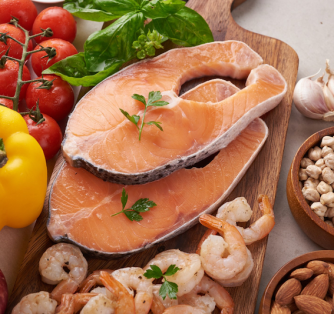Menu
Weight loss
Hormones
Sex
EXPLORE
MEET NU IMAGE MEDICAL
TREATMENTS
MEET NU IMAGE MEDICAL
TREATMENTS
MEET NU IMAGE MEDICAL
What is The Flexitarian Diet and What Foods to Eat?


Let’s face it. Losing weight is hard work. Many diets are restrictive and hard to stick to. Some people consider going vegetarian or vegan to lose and maintain weight. While these are great diet options, they are very hard to stick to.
However, there is an alternative to such restrictive diets, and it may not be as difficult as you think. You really can have the best of both worlds by starting a Flexitarian Diet. Designed by dietician, Dawn Jackson Blatner, the Flexitarian Diet allows you to reap the benefits of a vegetarian diet without giving up the animal products you enjoy.
According to experts, the Flexitarian Diet is a combination of the words, vegetarian and flexible. Being a flexitarian is not so much about going on a diet. Instead, it is a lifestyle change. You have vegetarians, and you have vegans. Vegetarians eat primarily vegetables, but also chicken and fish. Vegans, on the other hand, eat only fruits and vegetables. Like veganism, the Flexitarian Diet is essentially a lifestyle. With the Flexitarian Diet, it is recommended that you do not eat meat for two days out of the week, according to WebMD. Because this diet is heavy on plant-based products, you consume fewer calories than you would with meals containing large amounts of meat.
The unique thing about the flexitarian diet lifestyle is that you have some leeway, when it comes to the foods you eat. Those on the Flexitarian Diet are neither vegans nor vegetarians, because they eat a combination of different foods that are deemed healthy. However, the key is limiting meat more than anything else. “Advanced flexitarians” or those who are serious about the diet may go meatless three to four days per week.
Flexitarians aren’t limited to a specific set of foods, such as chicken and fish. Instead, they can choose what they want. There are no hard and fast rules that you must consume a set amount of nutrients and calories. The Flexitarian Diet is very flexible, but you must also stick to healthy foods that are a part of healthful diets. As a general rule, flexitarians focus on eating mainly fruits, vegetables, whole grains, and legumes. The majority of protein they consume comes from plants, instead of animals. You can eat a variety of vegetables, including corn, salsa, tortillas, bread, blueberries, and melons. You can also load up on nuts. Nuts are a great source of protein.
People who follow a Flexitarian Diet can have sugars and sweets. However, these must be consumed in moderation and only once in a while. Flexitarians also eat foods that are minimally processed and natural. The overall goal of this diet is to eat healthy foods, while limiting the amount of meat you consume. Minimally processed foods are essential to this diet and make up a large part of it. If you’re going to eat meat, experts recommend limiting your consumption to 28 ounces per week.
Because you decide what foods you want to include and restrict, you don’t feel so limited in your choices. You have the freedom to eat some things that you want. While this diet affects your meat consumption, it does not restrict you as much as a vegetarian diet does.
So, what are the benefits of the Flexitarian Diet? According to the Cleveland Clinic, the Flexitarian Diet helps lower your risk of heart disease and Type 2 diabetes. Additionally, it may help fight cancer or lower your chances of developing it.
The Flexitarian Diet is also good for the environment because it decreases your consumption of meat. This decreases your “carbon footprint.” One of this diet’s greatest benefits is the fact that you can vary up the food you eat. But also be aware that the diet has drawbacks as well.
According to experts, this diet can be risky for certain individuals. Limiting your meat consumption can lead to vitamin deficiencies. This can cause low levels of Vitamin B12 and may cause you to miss out on the zinc and calcium your body needs to function effectively.
Those who suffer from Irritable Bowel Syndrome (IBS) may not react well to a diet that is so dense with plant-based products. If you have issues with your digestion, you should research which fruits and vegetables your system can tolerate. So, what foods can you eat on the Flexitarian Diet? It is very important to limit your consumption of highly-processed foods. You should focus on consuming natural foods that have not been extensively modified. Fresh fruits and vegetables are best.
There is no need to count calories on this diet, because plant-based food comes from the ground. Because of this, it is free of chemicals and unnatural ingredients. It is important not to limit your consumption of animal protein on the Flexitarian Diet. You should eat a lot of fruits, vegetables, and plant proteins. Edamame, tofu, lentils, and chickpeas are excellent sources of plant-based proteins, and are recommended for those on the Flexitarian Diet. You don’t have to become a total vegetarian on the Flexitarian Diet, but you are pretty close.
Whole grains, such as oats, barley, and quinoa, are allowed on this diet. Dairy should be limited, but can be consumed in moderation, if desired. If you’re going to drink milk, make sure it is plant-based. Cheese and yogurt are also great dairy options for those who don’t want to consume milk.
Eggs are a great source of protein and are generally recommended. Eggs are especially good for you, because they are filled with protein, and keep you full longer than other non-protein foods.
According to US News & World Report, the Flexitarian Diet is the second-best diet for those with diabetes. People are better able to stick to this diet, because of its flexibility. According to experts, the Flexitarian Diet has one of the healthiest menu plans. Because of this, more and more people are identifying themselves as flexitarians. When you think about it, the Flexitarian is really just a healthy way of eating. By upping your activity levels, eating healthy food on this diet can lead to an overall healthy lifestyle. It can also help you maintain your weight.
While the Flexitarian Diet is effective, some have questions about its safety. Your body needs certain nutrients that are found in meat. According to PubMed, it is important to consume a “combination of foods” to be successful on any diet. The Flexitarian Diet requires you to eat more vegetables, but it can sometimes be hard to figure out what to eat for meals. If you’re looking for a healthy flexitarian breakfast, you can fix up fruits, such as berries, apples, and peaches. You can also have starchy vegetables, such as corn and sweet potatoes. Oats, nuts, and nut butters are also great options.
If you are looking for a healthy Flexitarian breakfast, you may want to consider making individual Frittatas or maple orange bread pudding French toast. The fact that the Flexitarian Diet isn’t a diet at all makes it easier to stick to. If you’re looking for lunch ideas, you could have Mediterranean stew or beefless vegan tacos. There is also a plethora of healthy lunches to include in a Flexitarian Diet. Roasted veggie enchilada casserole is a great meal for Flexitarians. This type of casserole does not contain any meat, but it is filled with layers of salsa, vegetables, tortillas and beans.
The goal of the flexitarian diet is not to lose weight, but instead to improve your lifestyle for the better. If you are on a Flexitarian Diet, it may help to lay out a meal plan for a week. For breakfast it may help to plan out granola-based meals, such as Tahini-spiced granola. Peanut butter and jelly smoothies also make a nice breakfast. Write out a plan that details meals you’re going to eat each day, but don’t limit yourself strictly to the meals listed in your plan. You can change up recipes by adding extra plant-based ingredients.
While this is a great lifestyle for many people, also be aware that it is not for everyone. If you don’t want to try different types of vegetables and consume alternative sources of protein, be wary. Consuming too many vegetables can result in gastrointestinal problems, such as diarrhea. Meal preparation is pretty easy, but you will need to buy a lot of fresh produce to keep up with the diet’s requirements. You should exercise for 30 minutes each day to maintain good health. If you want even more activity, you can set aside 90 minutes each day for exercise.
Because the Flexitarian Diet requires that you eat a lot of produce, it is a great alternative for vegetarians and vegans who want to change up their diet. Eating foods, such as meats, prevents boredom and allows you to switch up your diet by adding in items that were once “forbidden foods.”
Although food can be expensive, shopping for food on the Flexitarian Diet may be lighter on your wallet. Vegetarian proteins, such as beans and tofu, are typically less expensive than poultry and meat. You still have the added cost of meat, but you may not need to buy too much of it. You can also vary up this diet and modify your meals to accommodate your own personal taste.
12 Sources
Nu Image Medical has strict sourcing guidelines to ensure our content is accurate and current. We rely on peer-reviewed studies, academic research institutions, and medical associations. We strive to use primary sources and refrain from using tertiary references.
https://www.healthline.com/nutrition/flexitarian-diet-guide
https://www.hsph.harvard.edu/nutritionsource/processed-foods/
https://health.clevelandclinic.org/what-is-the-flexitarian-diet/
https://www.healthline.com/health/irritable-bowel-syndrome
https://pubmed.ncbi.nlm.nih.gov/33535684/
https://www.thekitchn.com/flexitarian-meal-prep-plan-22977762
https://www.webmd.com/diet/a-z/flexitarian_diet
https://diabetesstrong.com/flexitarian-diet-for-diabetes-management/
https://www.cuimc.columbia.edu/news/what-plant-based-diet-and-it-healthy
This article is for informational purposes only and does not constitute medical advice. The information contained herein is not a substitute for and should never be relied upon for professional medical advice. Always talk to your physician about the risks and benefits of any treatment. Nu Image Medical may not offer the medications or services mentioned in this article.
